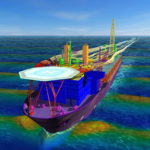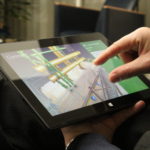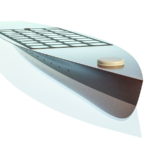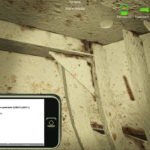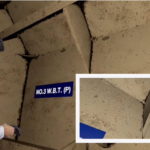The 16th Conference on Computer and IT Applications in the Maritime Industries (COMPIT) will be held 15–17 May in Cardiff/UK. A preview by organizer Volker Bertram
of Tutech Innovation and DNV GL
Over the past two decades, COMPIT has established itself as a key conference in information technology (IT) for the maritime[ds_preview] industries, bringing together software developers and users. Most participants come from the industry, reflecting the practical relevance of the event.
This year, the main trends in IT for the maritime industry are:
• Integrated design environments. Standalone solutions for simulation-based design give way to integrated solutions. »Simulation centres« handle data import, smart and user-friendly model generation and intuitive result display for design decisions.
• Shipyard 4.0. Yards get smart, too. The Internet of Things (IoT) and smart decision support systems play a key role here.
• Virtual Reality spreads. We have to thank our kids – the video game industry has provided cost-effective software and hardware solutions for Virtual Reality (VR) and Augmented Reality (AR). From training to hull inspection, from preparing nautical officers to shopfloor support in shipyards. VR and AR have arrived in our industry and flourish.
Best-of-breed solutions with common user interface
Despite numerous attempts, there is no single monolithic software program that is optimal for all tasks. However, design frameworks (a.k.a. simulation centres) evolve. These group dedicated software codes in a larger framework with a common »same look and feel« user interface. The integration may be »hardwired« for a single vendor, but may also via a common integration surface, calling different codes from different vendors, supporting the popular »best of breed« approach in design software. Data exchange in such frameworks is largely or fully automated, reducing both training time and project time. The framework trend is demonstrated in a variety of papers by several well-known vendors, many coming from joint industry projects.
Mergers and alliances consolidate the software market and support the development towards larger and more comprehensive design environments. The acquisition of CD-Adapco (CFD) and LMS (noise & vibration, fatigue strength and kinematics) by Siemens is a classic example of the general trend. Bundling assorted simulation competence under the Siemens umbrella is likely to lead to a new super-heavyweight in the maritime software market. Radosavljevic and Cardoen (Siemens) describe Siemens PLM Software’s new solution for cross domain and multi-physics simulation in »Simcenter – Enabling Predictive Engineering Analytics«, giving assorted simulation and optimization applications.
Pawling et al. (UCL) point out the trend towards »Expanding the Scope of Early Stage Computer Aided Ship Design«. Design, particularly for complex ship types, incorporates increasingly a wider range of aspects than straightforward numerical performance analyses. A whole session is dedicated to layout design, using an inside-out approach known as Design Building Block approach, where UCL, TU Delft and the University of Michigan have evolved as key technology drivers. Pawling et al. also look into some interesting new developments adapting techniques from other industries to ship design. One example is »real options theory«, a technique from financial market assessment which can be used for handling uncertainty in complex scenarios.
Korbetis et al. (BETA CAE Systems) present »EPILYSIS – A New Solver for Finite Element Analysis«, which streamlines the processes further in CAE workflow of structural analyses. The paper illustrates how in mature simulation techniques (strength and vibration, stability and CFD) the focus lies increasing on reducing time spent on model generation and data transfer between different software interfaces. The quest is not per se for new applications, but rather for new users, shifting simulations from dedicated simulation experts to the designer.
The key is then making the software user-friendly and affordable. The solution is not rocket science, but common good engineering sense: re-use models wherever possible, offer macros for frequently performed operations, make the user interface more graphical and intuitive.
Grümmer et al. (aXatlantic, Friendship Systems, TU Berlin) are cross domains with their »Optimization of a Self-Righting Hull Design and Thruster Unit for an Autonomous Surface Vehicle«. The project uses the German design framework CAESES for hull generation and optimization process management with MAXSURF Stability for volume and stability calculations to maximize the stability of a solar-powered, self-righting drone. The aXatlantic project aims for a world record for the first solar-powered and autonomous ocean crossing. Which brings us to a theme that dominates the central day of COMPIT 2017: Autonomous ship technology.
Autonomy now – or maybe a little later?
Autonomous means independent – systems perform some tasks independently that so far has been performed by humans. There are various levels of autonomy, e.g. independently coming up with a suggested path for collision avoidance is a lower level than independently performing the collision avoidance manoeuvre. Smart usually indicates large amounts of (sensor) data being processed typically with some local processing intelligence. Unmanned means no crew on board, but could refer to a remotely controlled ship.
A key task in more or less autonomous navigation is path planning and execution of collision avoidance manoeuvres. The first field tests and commercial decision support systems date back to the 1990s, but work continues on higher autonomy, refined algorithms and preparation for an era where unmanned (and highly autonomous) ships may operate side by side in congested traffic with manned (and more or less autonomous/automated) ships – think fleets of Google cars mixing with many »conventional« drivers in tomorrow’s traffic on our streets. This era may come faster than some of us think. Various groups around the world are working on it. Daltry & Tripp (ASV Global) present »The Path to Real World Autonomy for ASVs«, using a hierarchy of autonomous systems to plan efficiently and (hopefully) safely collision avoidance. Mediavilla et al. (Lloyd’s Register, Rolls-Royce, et al.) work on the »MAXCMAS Project – Autonomous COLREGS Compliant Navigation«. The MAXCMAS (MAchine eXecutable Collision regulations for Marine Autonomous Systems) project develops a COLREGs compliant path planner for autonomous vessel guidance and control. The explicit and deterministic rules of the collision avoidance rules (COLREGs) are the easy part, but some COLREGs involve personal judgment, e.g. when to initiate emergency collision avoidance when the counterpart does not give way. Then rules for an expert system can be determined by observing human experts in similar situations, typically employing nautical simulators. Again, we see the power of combining advanced IT techniques (simulation, Augmented Reality, autonomous/robotic technology and Artificial Intelligence in this case). Totem Plus in Israel already offers a commercial collision avoidance system for unmanned ships without radio contact, as described in Levy’s »Totem Autonomous Navigation System«.
Key technologies for future ship operation – whether smart, autonomous or unmanned – are Big Data and the Internet of Things (IoT). Mary Etienne (Dell EMC) sees »IoT: Maritime’s Next Wave« already transforming the maritime industries, from design to operation. As sensors become smaller, more robust and cheaper to acquire, we predict that they will be »everywhere,« in the hull, main engine, and auxiliary machinery and even small equipment items, gathering and collecting data for analysis. Whether ships and the equipment on them are operated locally or by remote control, operational decisions will be data driven. Patrick Müller’s (Siemens) »Marine 4.0: Condition Monitoring for the Future« illustrates the role of IoT and Big Data for the case of engine maintenance seeing major cost savings in adopting the technologies. Another example of the power of Big Data is given by Deverill & Bakharevski (Genscape Vesseltracker) in »Big Data – Processing Global AIS in Real Time to Produce Unique Market Insight«. Genscape Vesseltracker processes 500 mill. daily AIS messages in real time, filtering for all types of ship events, merging the information with a detailed geographical database of maritime locations and facilities, and filtering against databases of ship, terminal and company information to provide market insight. However, all these technologies are based on connected wireless IT systems. And these come with increased cyber risks. Patterson & Barton (Babcock) look in »Secure Wireless Options in the Smart Ship« at cyber-security, another hot topic in the maritime industries. They assess personal and local area wireless communication technologies, particularly with respect to their potential utility in ships. They recommend operational and design considerations to limit exposure to threats.
Virtual reality – it’s a different game now!
»Virtual Reality (VR) has gone from being science fiction, to being realized in the research lab, to being treated as a toy, to being used in practical applications, including shipbuilding,« says Denis Morais (CTO of major ship CAD vendor SSI). SSI’s state-of-the art description »The Evolution of Virtual Reality in Shipbuilding« gives a perfect introduction to the topic. It also predicts the future of VR by analysing the forces that have either hindered or promoted the implementation of Virtual Reality in ship design and construction. The diversity of applications is as fascinating as the level of realism achieved by CGI (computer generated imagery). Bertram & Plowman (DNV GL) review »Maritime Training in the 21st Century« seeing also maritime training becoming more and more digital. As an example, they describe a VR based training tool for ship surveying, where trainees can practice finding various deficiencies simulated in the virtual environment.
Cabos & Wolf (DNV GL) see VR playing a key role in actual surveys of the future. Upcoming inspection techniques such as drones and self-localizing cameras may enable full visual mapping of tank condition on a 3D ship model. Their paper »Virtual Reality Aided Remote Hull Inspection« explores in how far this could allow structural condition assessment to be performed remotely, making surveys faster, smarter and safer.
Sounds like Science Fiction? Maybe, but the future has already started. Virtual and Augmented Reality will play on centre stage. VR is the complete modelling of virtual worlds in the computer, while Augmented Reality (AR) overlays computer information over real-world views (think Pokémon Go). Helle et al. (University of Turku) give an overview of »Virtual and Augmented Reality Solutions to Industrial Applications« in Finland. While some industrial solutions have already been taken into actual use, attitudes towards the new tools vary widely in the industry as the authors found in user interviews. Procee (NHL Hogeschool) gives us a glimpse of Captain Picard on future ships in »Effect of Augmented Reality on Human Performance in a Ship’s Bridge Simulator«. In his studies, AR helps the navigator in detecting dangerous targets by the overlay of a synthetic image, thus providing a visual cue over the real world outside the bridge window. A head mounted display is used to project the augmented image. The prototype system was tested in the controlled environment of a nautical simulator. The paper presents first results of a larger program of empirical tests into the usability of AR in ships navigation.





